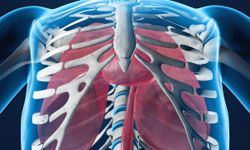Survival Benefit Seen With Frontline Tremelimumab/Durvalumab/Chemo in Some mNSCLC
The combination of tremelimumab plus durvalumab and chemotherapy in the first-line elicited survival benefit in patients with metastatic nonsquamous cell non–small cell lung cancer who harbor STK11, KEAP1, and KRAS mutations.

First-line tremelimumab, durvalumab (Imfinzi), and chemotherapy, appeared to be associated with overall (OS) and progression-free survival (PFS) benefit among patients with metastatic nonsquamous cell non–small cell lung cancer (NSCLC) who harbored STK11, KEAP1, and KRAS mutations, according to results from an exploratory analysis of the phase 3 POSEIDON trial (NCT03164616) that were presented at the 2022 World Conference on Lung Cancer.1
“We were able to use this exploratory analysis to demonstrate this trend of OS benefit in this patient population that is often characterized by usually by poor outcomes and poor responses to therapy, [including] STK11, KEAP1, and KRAS-mutant NSCLC,” said Solange Peters, MD, PhD, professor and chair of medical oncology and thoracic malignancies in the Department of Oncology at the University Hospital of Lausanne, Switzerland.
In the population of patients with STK11 mutations, investigators reported a 24-month OS rate of 32.3% (HR, 0.56; 95% CI, 0.30-1.03) among patients treated with the triplet regimen compared with 20.6% (HR, 1.03; 95% CI, 0.59-1.84) in the durvalumab/chemotherapy alone arm and 4.5% in the chemotherapy alone arm. Moreover, 24-month OS rates for patients with SRK11 wild-type disease were 42.8% (HR, 0.73; 95% CI, 0.57-0.93), 38.1% (HR, 0.81; 95% CI, 0.64-1.04), and 30.6% in each arm, respectively.
Patients with a KEAP1 mutation demonstrated a 24-month OS rate of 35.0% (HR, 0.43; 95% CI, 0.16-1.25) in the triplet group, 19.3% in the doublet group (HR, 0.77; 95% CI, 0.31-2.15), and 0.0% in the chemotherapy arm. For those with KEAP1 wild-type disease, the 24-month OS rates were 32.5% (HR, 0.79; 95% CI, 0.66-0.94), 30.3% (HR, 0.85; 95% CI, 0.71-1.01), and 23.2% in each arm, respectively.
Lastly, in the KRAS-positive cohort, the 24-month OS rates were 51.7% in the triplet arm (HR, 0.80; 95% CI, 0.62-1.04), 30.4% in the doublet arm (HR, 0.86; 95% CI, 0.66-1.12), and 25.6% in the chemotherapy alone arm. Among those with KRAS wild-type disease, the 24-month OS rates were 37.6% (HR, 0.80; 95% CI, 0.62-1.04), 36.8% (HR, 0.86; 95% CI, 0.66-1.12), and 28.3% in each respective cohort.
The POSEIDON trial included 1013 patients with stage IV NSCLC with either EGFR or ALK wild-type disease and an ECOG performance status of 0 or 1. The population also needed to be treatment-naive for metastatic disease and have received a tumor biopsy and baseline plasma sample for circulating tumor DNA (ctDNA) analysis. Patients were stratified based on PD-L1 expression, histology, and disease stage.
Those who enrolled on the study were randomly assigned 1:1:1 to receive either 1500 mg of durvalumab, limited-course tremelimumab at 75 mg, and chemotherapy every 3 weeks for 4 cycles; durvalumab and chemotherapy every 3 weeks for 4 cycles; or platinum-based chemotherapy every 3 weeks for up to 6 cycles. After initial treatment, patients in the triplet arm received tremelimumab at week 16 and durvalumab every 4 weeks until progressive disease, and the doublet arm received durvalumab every 4 weeks until progressive disease; maintenance pemetrexed every 4 weeks was option.
The study's alpha-controlled end points were PFS and OS.
Of the patients who enrolled on the study, 637 had nonsquamous histology, including 6% who had evaluable tissue only, 52% had evaluable tissue and ctDNA, and 38% had evaluable ctDNA only. This left a mutation-evaluable population of 612 patients. Of this population, 30% had KRAS-mutant disease, 14% had STK11-mutant disease, and 6% whad KEAP1-mutant disease.
Additional findings indicated the 12-months PFS rates for the STK11-mutant population were 34.6% in the triplet arm, 24.9% in the doublet arm, and 0.0% in the chemotherapy arm, and the median PFS for each group was 6.4 months (HR, 0.47; 95% CI, 0.23-0.93), 2.9 months (HR, 1.02; 95% CI, 0.55-1.93), and 4.6 months.
For those in the KEAP1-mutant subgroup, the 12-month PFS rate was 30.6% in the triplet cohort, 25.4% in the doublet cohort, and 0.0% in the chemotherapy cohort. Additionally, the median PFS was 5.0 months (HR, 0.94; 95% CI, 0.33-3.35), 2.8 months (HR, 1.51; 95% CI, 0.55-5.25), and 5.1 months in the triplet, doublet, and chemotherapy arms, respectively.
Lastly, the 12-month PFS rates within the KRAS-mutant group were 40.0% in the triplet arm, 32.2% in the doublet arm, and 20.0% in the chemotherapy arm, with a median PFS of 8.5 months (HR, 0.57; 95% CI, 0.35-0.92), 6.4 months (HR, 0.82; 95% CI, 0.53-1.29), and 4.7 months, respectively.
Moreover, the overall response rate (ORR) was 45.2% (95% CI, 27.3%-64.0%) in the triplet arm with a median duration of response (DOR) of 13.6 months (95% CI, 5.1–not evaluable [NE]. ORRs in the doublet and chemotherapy arms were 29.4% and 27.3%, respectively, with median DORs of 12.7 months and 3.3 months.
ORRs for those in the KEAP1 group were 45.5%, 21.7%, and 33.3% among those treated with the triplet, doublet, and chemotherapy regimens, respectively, with median DORs of 16.4 months, not reached (NR), and 4.6 months.
Within the KRAS-mutant cohort, the ORR was 55.0%, 43.3%, and 21.2% for patients treated with the triplet, doublet, and chemotherapy regimens, respectively. The median DOR in each respective group was NR, 12.5 months, and 5.4 months.